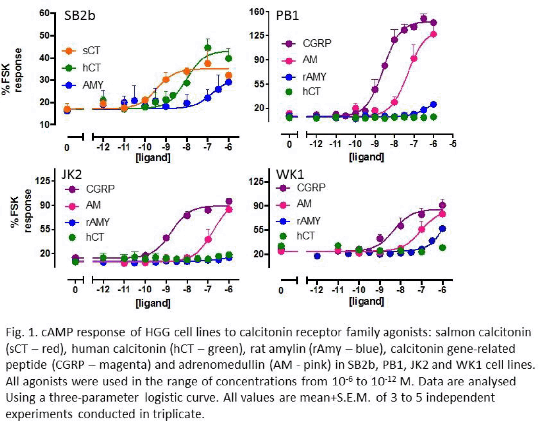Print version
Search Pub Med
| 190P London, UK Pharmacology 2017 |
Pharmacological analysis of the calcitonin receptor family in patient-derived high-grade glioma cell lines
Introduction: Glioblastoma multiforme (GBM) is the most common and aggressive primary brain cancer. The calcitonin family of receptors, calcitonin (CTR), amylin (AMY; CTR/RAMP), adrenomedullin (AM1, CLR/RAMP2 and AM2, CLR/RAMP3) and CGRP (CGRP1; CLR/RAMP1) are expressed in various cancers, including GBM1,2 and implicated in cancer progression. Immuno-histochemical data from patient-derived tumour biopsies demonstrated CTR expression in GBM1. To test the hypothesis that CTR, in particular, or other members of the calcitonin receptor family may be useful targets for treating GBM we performed pharmacological characterisation in 4 patient-derived high grade glioma (HGG) lines (SB2b, Pb1, JK2 and WK1), representing 3 GBM subtypes and capable of recapitulating the original disease in orthotopic xenograph models.
Methods: HGG cell lines (passages 8-30) were cultured in defined media3. Taqman mRNA expression analysis was performed according to manufacturer's direction, cAMP response was measured 30 minutes after stimulation1 and cell proliferation was measured by phase contrast in an Operetta. Data are presented as mean+SEM of 3 to 5 independent experiments conducted in triplicate.
Results: All cell lines had detectable levels of mRNA encoding components of CT, AMY, AM1 and CGRP receptors. In cAMP assays only the SB2b line showed a response consistent with functional CTR (only) whereas the other three only exhibited responses consistent with the CGRP receptor. CTR expressed in the SB2b cell line showed limited activation of ERK1/2 and p38 MAP kinase pathways and intracellular Ca2+ mobilization. In proliferation assays on the SB2b cell line we could not measure any effect of CTR agonists or antagonists on proliferation rate over 3 days treatment.
Conclusions: Although immunohistochemical data demonstrated abundant CTR expression in GBM biopsies1 and expression at the level of mRNA was observed in HGG lines only one out of four showed functional CTR. This might be due to expression of alternatively spliced receptor variants with impaired signalling in the other 3 cell lines or modifying effects of culture conditions on receptor expression. Even in the single cell line expressing CTR, we were not able to detect CTR dependent growth modulation. The CGRP receptor appears to be more widely expressed in HGG cell lines and, thus, might have more future potential as a marker/target for GBM treatment. Lastly, no correlation between receptor profiles and GBM subtypes were observed.

References:
1. Wookey et al. (2012) Histopathology, 60(6), 895-910.
2. Ostrovskaya et al. (2016) Reference Module in Neuroscience and Biobehavioral Psychology, 1-12.
3. Grundy et al. (2016) Sci Rep. 6:23353.

